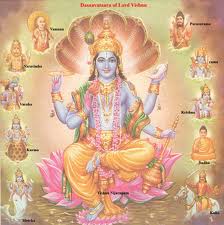| 1 Invocation | |
Shriyam Sarasvateem Gaureem Ganesham Skandameeshvaram, ‘Agni Purana’ is the essence of Vedas and Upanishads. It underlines the concept of ‘Advaita Brahma Gyan’ (Awareness of Unity of Almighty and the Self). In other words, Human Soul and the Supreme Power are one and the same. Also, the Purana emphasizes on the ritualistic aspects and religious practices related to temples, installation of idols, idol worship, ‘Japas’ (repetitive recitation of ‘Mantras’), ‘Homams’ and ‘Yagnas’, visits to ‘Thirthas’ (Holy Places including Rivers, Worship Spots and ‘Ashrams’ (places where Religious Leaders and Godmen seek retreat,) and so on. Spread over some 383 chapters over twelve thousand “Shlokas’, Agni Purana contains the gists of the Ten Avatars/ Incarnations of Lord Vishnu viz. ‘Matsya’, (Fish), ‘Kurma’ (Turtle), ‘Varaha’ (Boar), ‘Narasimha’ (Man/Lion), ‘Vamana’ (Dwarf), ‘Parasurama’, ‘Rama’, ‘Krishna’, ‘Buddha’ and Kalki. It also gives a detailed account of the Great Hindu Epics of ‘Ramayana’ and ‘Maha Bharata’ as also of ‘Harivamsa’.There are references in the Purana to Physical Features of World, Varnashrama and Ashrama Dharma, Temple Construction, Procedure of Pujas, Achaara Varnana, Tirtha Mahatmya, Power of Gayatri Mantra, Yoga Practice, Vedas and Puranas, Dhanurveda and Principles of Battle, Duties of Kings, ‘Brahma Gyan’, Bhagavat Gita and Yama ‘Gita’. Shri Lakshmi Stotra, Vishnu Panjara Stotra and Paapa Naasha Stora are other highlights. Being the Preserver of the Universe, Lord Vishnu takes to human form on earth occasionally whenever an evil force takes an extreme presence to upset the equilibrium of human existence and destroys the evil to re-establish and vindicate righteousness. The Lord had already taken to nine such ‘Avatars’ (incarnations) and the Tenth is in the offing as the Contemporary ‘Yuga’ (the fourth and final cycle of Time viz. ‘Kali’ Yuga, preceded by ‘Dwapara’ Yuga, ‘Tretha’ Yuga and ‘Kritha’ Yuga)) would be terminated. |

 Next:Invocation
Next:Invocation